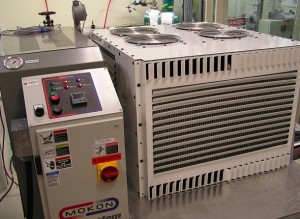It sounds a little counterintuitive, but the wasted heat from automobile tailpipe emissions could one day be used to cool and power your car.
Researchers from Oregon State University developed a thermally activated cooling system that harnesses the energy in waste heat produced by cars, factories, and power plants, and converts it to cooling. The system works by combining a vapor compression cooling cycle with an “organic Rankine cycle,” an existing energy conversion technology, to convert waste heat from a thermal source to generate power and cooling.

Engineering researchers at Oregon State University developed a prototype thermally activated cooling system that converts waste heat to cooling. (Credit: OSU)
By turning 80 percent of every kilowatt of waste heat into a kilowatt of cooling capability, the system recycles exhaust heat that would otherwise escape into the atmosphere. The cooling system could be used to ventilate electronics systems that also require energy-intensive air conditioning to keep cool.
“This technology would be especially useful if there’s a need to have cooling systems where heat is being wasted,” Hailei Wang, OSU research associate, said in a news statement. “That’s one reason the research has been supported by the Department of Defense, because they see it being used to provide needed air conditioning for electronics and other purposes when they are using generators in the field.”
The energy recycling technology could also be used in vehicles to help power hybrid cars. Although less efficient than converting exhaust to cooling, the prototype can also be used to produce electricity to propel a vehicle. Only 15 to 20 percent of the waste heat can be converted to produce electricity, but it’s better than letting the energy go to waste.

 Follow
Follow